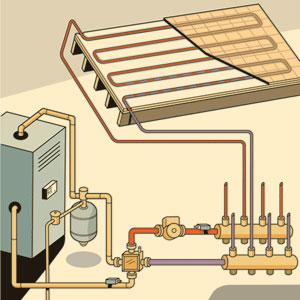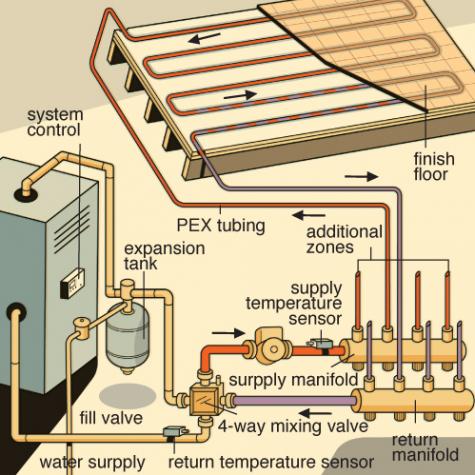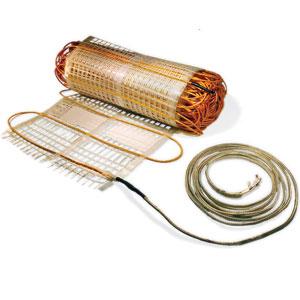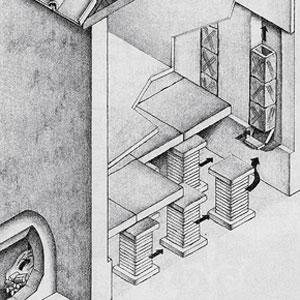
The best heating system a house can have is the one you don't realize is there. No radiators clanking in the night.
No vents whooshing like a jet preparing for takeoff. No dust-spewing ductwork to run up your allergists' bills. Just
an even blanket of heat, right where you want it.
That's the appeal of radiant floor heating, says This Old House plumbing and heating expert Richard Trethewey,
who has long been a fan. "It's truly invisible," he says. But a radiant heat system has more than just aesthetics going
for it. It's also a highly efficient way to heat a house, increasing comfort as it reduces energy costs.
In a radiant setup, the warmth is supplied by hot-water tubes or electric wires buried underneath the floor. As the
invisible waves of thermal radiation rise from below, they warm up any objects they strike, which radiate that captured
heat in turn. Though the air temperature remains relatively constant, you stay comfortable because the surrounding
surfaces aren't stealing warmth from your body.
Contrast that with what happens in a conventional forced-air heating system, the kind found in most American homes.
Air blows out of the registers at a well-baked 120 degrees, rises to the top of the room where it quickly sheds heat,
then drops back down as it cools. The air in the room becomes uncomfortably stratified: Your head can be bathed in
warmth while your toes lie in the frozen zone. Then there's the problem of cycling. "You turn on the furnace, it quickly
takes you to 68 or 70, and then shuts off," says Richard. The result is a phenomenon he calls "the cold 70," which is
what you feel right after the hot air stops pumping from the registers. Those jarring ups and downs are absent with
radiant floors, which may reach 85 degrees, tops, on a frigid day. The warm air still rises, but it does so evenly over
the entire floor, so the coolest air stays up at the ceiling. "You're heating where the people are," Richard says.
There are two basic types of radiant floor heating that supply this gentle, even warmth: hot water or electricity. Electric
radiant, which uses zigzagging loops of resistance wire, is ­generally retrofitted to a single room, such as a bathroom or
kitchen. (See "The Floor Electric," above.) Hot-water "hydronic" systems—the most popular and cost effective way to
heat an entire house—circulate water from a boiler or water heater through loops of 1/2-inch polyethylene tubing. The
flexible tubes can be installed in a variety of ways: on top of the subfloor in grooved panels or snap-in grids; clipped ­into
aluminum strips on the underside of the floor; or embedded in poured concrete. Once the system is in place, you can
cover it with most types of finish flooring, including hardwood and tile. Carpet, however, can be tricky, especially if it has
thick padding underneath. "If the floor is too well insulated, radiant heating really ­doesn't make sense," Richard says.
"It's like putting a sweater over a radiator."
Hot-water radiant costs more to install than other types of heating systems—from $6 to $15 per square foot depending
on the method, whether you're starting from scratch or retrofitting, and where you live. (New builds where the tubes are
buried in concrete slab tend to be the least expensive). And you'll still need a separate air-conditioning system for cooling.
But if the price tag puts you off, consider this: Once it's up and running, a radiant heat system can be up to 30 percent
more efficient than forced-air heating, depending on how well insulated a house is. And there's no comparison when it
comes to comfort. In that category, radiant always wins, feet down.

Hydronic Radiant System
What It Is:
An efficient home heating system that turns entire floors into radiators, warming living spaces without uncomfortable
hot or cold air pockets.
How It Works:
Hot water is pumped from a boiler through a loop of flexible tubing embedded in the floor.
Why You'd Want One:
Eliminates forever the discomfort of cold floors as it slashes energy bills.
What To Look For:
Multiple heating zones: Makes it easy to fine-tune the amount of heat being delivered to different rooms.
Outdoor Reset Control:
Slowly raises and lowers the amount of hot water flowing through the tubing in response to changing outside temperatures.
Pex Tubing:
Specially treated polyethylene carries the hot water for hydronic systems. Unlike copper, this inert plastic won't corrode
and can be installed in long runs with just a couple of fittings, reducing the chance of leaks.
What It Costs:
$6 to $15 a square foot for installation. In general, expect to pay 50 percent more for a hydronic radiant flooring system
than for conventional forced-air heat.
Where To Get It:
No one manufacturer supplies all the components for hydronic radiant heating. You'll need a good heating contractor to
put a system together. With electric radiant, it's easy to find turnkey systems.

The Floor Electric: For an alternative to the cost and complication of a hydronic system, there's electric radiant heat.
Its warmth comes from a loop of thin electric wire laid directly under the finish floor. No boiler, no water, no 1/2-inch-thick
tubing to alter the floor's height. You'll need an electrician to connect the wiring to the panel, but the rest of the
installation is no more difficult than laying tile. The catch lurks in your utility bill: the 6 to 10 watts per square foot the
system uses per hour makes it prohibitively expensive to heat a whole house. It's best for spot heating, such as taking
the chill off a tiled bathroom or stone countertop.
Radiant Foors From the Romans to Wright
Radiant heat dates to ancient times, when the Romans warmed rooms by running the flues for slave-tended, wood-burning
fires under elevated marble floors, keeping toes and togas nice and toasty.
Many centuries later, in this country, Frank Lloyd Wright buried copper pipes in the concrete floors of his Usonian homes
and warmed them with hot water. A few postwar subdivisions, including Levittown, followed suit. But when the pipes
eventually corroded, most home­owners abandoned radiant rather than jackhammer their floors.
Today, plastic PEX tubing has replaced metal as the favored means of feeding hydronic heat into floors, making radiant
heat systems more affordable than ever. And with a no-fail track record in Europe going back more than 35 years, it's
also made them more reliable.
Muller Construction Technology Ltd..

Where to Find It: